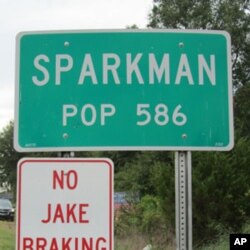The tiny timber town of Sparkman, Arkansas, has lost more than half its population since 1950. If the current trend continues, the 500-resident community might disappear altogether.
Anxious to avoid that grim future, residents have come up with an idea to save their hometown - a scholarship program for students who promise to return to Sparkman after receiving a college education.
Hometown girl
Stephanie Harmon was born in Sparkman 27 years ago.
“It’s always been a part of me," Harmon says. "I love this town.”
Except for the six years she spent getting her master’s degree in education in a neighboring city, Harmon has always lived in Sparkman.
“It’s a very intimate and close-knit town, almost like a one big family," she says. "Everyone knows everybody and we all take care of each other in different ways.”
Harmon is now married to another Sparkman native and teaches in the town's only elementary school.
“We want to do anything to educate our students," she says. "So it’s disheartening to hear students wanting to leave the town.”
High school graduates have to go away to continue their education, she explains, since there’s no college in town. But many of them find better job opportunities in big cities, and never come back. So Harmon and others decided to do something to encourage students to go to college and return.
Saving Sparkman
“We got together, several of us community members, and started this Sparkman Scholarship Foundation,” Harmon says.
The idea is not entirely new. Many communities in Arkansas and across the country offer students money to pay for their higher education. However, Harmon says the Sparkman scholarship is unique.
“Most scholarships such as ours are funded through wealthy benefactors or corporations or other foundations," she says. "Our scholarship has a uniqueness that really tells how wonderful our community is. We didn’t have a wealthy benefactor or foundation who is funding us. Our scholarship is completely funded by the residents of Sparkman and others with a heart for our town.”
One of those funders is Bill Sorrells, a retired grocery store owner who has lived in Sparkman for almost all his life. Although he doesn’t have kids of his own, Sorrells donated $500 to the scholarship fund.
“I plan to donate more each year, not just one time," Sorrells says. "It’s our kids. If we don’t help them, nobody else is going to help them. We hope these scholarships will encourage people to stay here and maybe even some people move here and help us to grow a little bit.”
As a condition of accepting the money, students agree to return to Sparkman after graduation, to live and work in town.
Win-win scenario
For Renee Brown, who has two young daughters, the scholarship program is a winning enterprise for everyone.
“One person can fund a scholarship program alone," Brown says, "but if everybody pools together, we can give, but still not have to give as much as we would if we had to pay for our children to go to college alone.”
Since its launch last March, the Sparkman Scholarship Fund has raised more than $56,000, the majority of that in just three months, according to Brenda Garrett, a member of the scholarship fund.
“We had people call after they saw articles in newspapers," Garrett says. "Though they had been away from Sparkman for a long time, they saw the story and connected and made a donation and let us know that they appreciated what we’re doing for their hometown.”
Four of Sparkman’s 12 high school graduates won a scholarship last summer, including Garrett’s son Sam. He's now studying mechanical engineering at Arkansas Technical University in nearby Russellville.
“I’m planning on going back after I get out of the college," Sam Garrett says. "Maybe me staying around would encourage a lot of peers to stay around too.”
America's vanishing small towns
Sparkman is not the only small town facing a shrinking population.
“The United States, as a whole, is growing at a very rapid pace so the population growth is not the problem," says Mark Mather, a demographer at the Population Reference Bureau. "The problem is that population growth in the U.S. is extremely uneven. It’s estimated that about 16 percent of the United States population lives in counties that are classified as non-metropolitan or rural counties. The number has dropped every decade for the past 100 years.”
Those who live in small towns and rural areas point to the benefits. For example, it’s less stressful and cheaper than living in metropolitan areas. However, one of the primary reasons people move away is the lack of job opportunities.
“When conditions get that bad," Mather says, "you end up in this vicious circle where new employers don’t want to move in because there is not many people living there and no one wants to move there because there aren't any jobs.”
The key to survival for these communities is job creation. Sparkman’s Harmon says that’s the goal of their scholarship program - to ensure their town survives and thrives.












